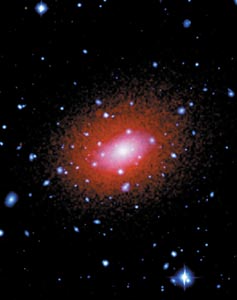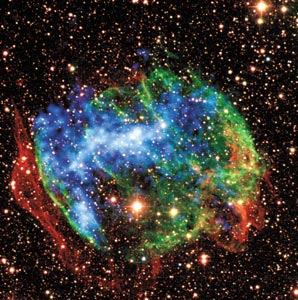
The existence and nature of dark energy has been probed using images of galaxy clusters obtained by NASA’s Chandra X-ray Observatory. These results are completely independent from the previous supernova results and confirm the effect of dark energy on the acceleration of the universe.
The first evidence for dark energy came in 1998 with the observation that distant type Ia supernovae are dimmer than expected. This suggested that the expansion of the universe is not decelerating under its own gravity but accelerating through the effect of some mysterious dark energy (CERN Courier September 2003 p23). The first results of the Wilkinson Microwave Anisotropy Probe (WMAP) confirmed in 2003 that dark energy is the main contributor to the matter-energy content of the universe (CERN Courier April 2003 p11). Along with additional observational constraints, a cosmological “concordance model” could be derived in which 4% of the present universe is made of baryons, 20-25% is non-baryonic dark matter of unknown nature, and dark energy accounts for the remaining 70-75%.
The new study led by Steve Allen of the Institute of Astronomy at Cambridge University is based on the X-ray emission of hot gas in 26 galaxy clusters (CERN Courier July/August 2003 p13). Using X-ray measurements from Chandra, the authors derive for each cluster the mass ratio of the hot gas to dark matter. Under the assumption that this gas fraction should be constant with redshift, they then adjust the distance scale to give a best fit to the data. This work suggests the existence of dark energy with a significance of >3σ (Allen et al. 2004). It thus offers the first clear confirmation of the results from type Ia supernovae by detecting the effect of dark energy on distance measurements for a different class of astronomical objects.
This study also suggests that the dark-energy density does not change quickly with time and may even be constant, consistent with Albert Einstein’s “cosmological constant” concept. The best estimation of equation-of-state parameter “w”, which describes the nature of dark energy, is, however, found to be slightly below -1. This implies that the universe might end in a “Big Rip”, where dark energy increases until galaxies, stars, planets and eventually atoms are torn apart (CERN Courier May 2003 p13).
However, it is important not to over-interpret the data by forgetting that they rely on some prior assumptions. For example, another recent study, also based on the X-ray emission of galaxy clusters, yielded the opposite result by showing that the redshift dependence of the number counts of galaxy clusters is nearly an order of magnitude below the expectations of the “concordance model”, while being in remarkable agreement with those of a matter-dominated universe (Vauclair et al. 2003). Such a classical Einstein-de-Sitter universe could even account for the WMAP results if the Hubble constant has the rather low value of 46 km/s/Mpc (Blanchard et al. 2003). The controversy over the existence and moreover the nature of dark energy is clearly not yet over.
Further reading
S W Allen et al. 2004 http://arxiv.org/ abs/astro-ph/0405340.
A Blanchard et al. 2003 Astron. Astrophys. 412 35.
S C Vauclair et al. 2003 Astron. Astrophys. 412 L37.
Picture of the month

Is this the remnant of a gamma-ray burst? If the answer is yes, then it would be the first one to be discovered in our Milky Way galaxy. This composite image of the supernova remnant W49B shows bright infrared rings (red and green) on both sides of a glowing bar of intense X-ray radiation (blue). The infrared rings are likely to have been expelled during the short life of a massive star. A few thousand years ago, when the star exhausted its nuclear fuel, its core collapsed to form a black hole. Much of the surrounding gas was pulled into the black hole, but some of it was probably flung away in oppositely directed jets, as witnessed by the remaining bar-shaped region of X-ray emitting gas. Those jets travelling near the speed of light could have produced a gamma-ray burst that might be observed, in a few billion years, by an observer in a remote galaxy located along the jet axis. (Credit: NASA/CXC/SSC/J Keohane et al.; Infrared: Caltech/ Palomar/J Keohane et al.)








